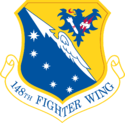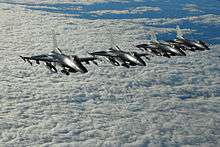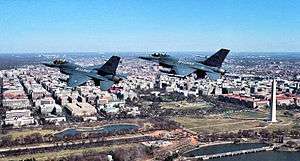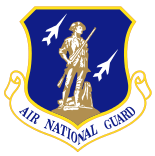148th Fighter Wing
| 148th Fighter Wing | |
|---|---|
|
F-16s from the 148th Fighter Wing flew combat air patrols over the Washington D.C. area in the months after 9/11 | |
| Active | 1 July 1960-Present |
| Country |
|
| Allegiance |
|
| Branch |
|
| Type | Wing |
| Role | Fighter |
| Part of | Minnesota National Guard |
| Garrison/HQ | Duluth Air National Guard Base, Minnesota |
| Tail Code | Blue tail stripe "Duluth" in white letters |
| Commanders | |
| Current commander | Col. Jon Safstrom |
| Insignia | |
| 148th Fighter Wing emblem |
 |
The 148th Fighter Wing (148 FW) is a composite unit of the Minnesota National Guard, stationed at Duluth Air National Guard Base, Minnesota. If activated to federal service, the Wing is gained by the United States Air Force Air Combat Command.
The 148 FW provides air defense of the northern great lakes and over the state of Minnesota. The Wing's 179th Fighter Squadron is a deployable unit which participated in Air and Space Expeditionary Force deployments. The wing also maintains a detachment (Det 1.) at Tyndall AFB, Florida.
Units
The 148th Fighter Wing consists of the following units:
- 148th Operations Group
- 148th Maintenance Group
- 148th Mission Support Group
- 148th Medical Group
History
On 1 July 1960, the 179th Fighter-Intercepter Squadron was authorized to expand to a group level, and the 148th Fighter Group (Air Defense) was established by the National Guard Bureau. The 179th FIS become the group's flying squadron. Other squadrons assigned into the group were the 148th Headquarters, 148th Material Squadron (Maintenance), 148th Combat Support Squadron, and the 148th USAF Dispensary.
On 1 July 1960, the 148 FIG assumed a 24-hour alert status in support of the Air Defense Command mission in Duluth. In 1967, the F-102A Delta Dagger replaced the aging F-89J. The F-101B Voodoo came aboard in April 1971 and remained until January 1976 when the unit again saw re-designation, becoming the 148th Tactical Reconnaissance Group with RF-4C Phantom II Mach-2 unarmed reconnaissance aircraft. The new mission entailed all weather, high or low, day or night, selective reconnaissance. This mission also required the unit to have the capabilities to deploy to a wide variety of operating locations. In October 1983, the mission changed again and found the 148th back in air defense and being renamed the 148th Fighter Interceptor Group. The return to alert and air defense brought with it the F-4D Phantom II, tactical fighter, with most of the aircraft being veterans of the Vietnam War.
Modern era


On March 10, 1990, the 179th Fighter Intercept Squadron received the first ADF variants of the F-16A/B Fighting Falcon to take over for the F-4D. The early markings included Duluth written on the tail as well as an image of the constellation 'Little Bear' which is also better known as the 'Big Dipper'.
Starting on 17 March 1992 the 179th FIS was renamed the 179th Fighter Squadron. A few years later in October 1995 the unit was tasked with a permanent detachment duty. Detachment 1 was an alert status mission based at Tyndall AFB, Florida.
To fit the needs of a newer global environment and shrinking air force in the United States, the squadron dropped the air superiority role and became a general purpose tactical fighter squadron. Proficient in the air-to-air mission, the 179th FS had to be brought up to speed using the F-16 for mud moving using both guided and unguided bombs. Live bombs were dropped for the first time in March 2000 during a training exercise. Due to these role requirements, the base also had to be renovated. During this transition the units tail flash was also changed. The constellation 'Little Bear' was dropped and a tail code adopted.
On September 11, 2001, the 148th FW became very busy as a result of the tragedy that saw the collapse of the two World Trade Center towers in New York City. As an immediate aftermath, the 148th was tasked with air defense at the Minneapolis-St. Paul International Airport, with providing Combat Air Patrols over Washington D.C. and New York City, and with deploying personnel and aircraft back to its detached alert facility at Tyndall AFB.
Towards the end of 2003 the 'Bulldogs' began conversion to the F-16C/D block 25. Most of the ADF's F-16A/Bs were retired straight to AMARC wearing the unit tail flashes. During the course of the conversion the 179th FS also gave up its requirements for Detachment 1 at Tyndall AFB. Now with the block 25 and multi-mission training led to combat deployments which had in the past excluded the 179th FS from participating.
As part of Operation Iraqi Freedom, the 179th was one of the first F-16 unit to be based in Balad AB. Iraq. The 179th deployed more than 200 personnel between April - June 2005. The squadron was mainly tasked with air-to-air and air-to-ground combat operations. Another deployment to Balad AB was set up between September–December 2008. The task was the same, conducting air-to-air and air-to-ground combat operations against insurgents.
On 27 April 2010 the squadron began another conversion being the first ANG unit to operate the block 50 F-16C/D when five aircraft arrived from Spangdahlem AB, Germany. This move saw the combination of both the 22d and 23d FS at Spangdahlem to become the reactivated 480th FS with the surplus aircraft going to the 179th FS. The majority of the block 25s were sent to retirement at Davis-Monthan AFB, Arizona.
Detachment 1, Tyndall Air Force Base

The 148th Fighter Wing Detachment is located at Tyndall AFB, FL. Detachment 1, 148th Fighter Wing is under the operational command of the commander-in-chief of the North American Aerospace Defense Command, Colorado Springs, CO.
Their main mission is to intercept "unknowns" when scrambled by controllers at the Southeast Air Defense Sector AOC, located at Tyndall. The deployed pilots also assist drug and law enforcement agencies in drug traffic interdiction. The unit provides maintains aircraft and crews on runway alert around the clock, 365 days a year, for the interception of possible illicit planes entering US air space from over the Gulf of Mexico.
The Detachment consists of 20 Minnesota National Guardsmen and four F-16C Fighting Falcon air defense fighters aircraft. The aircraft and pilots rotate on a scheduled basis from their home base at Duluth AGS. The commander, operations officer and 16 enlisted members of the Detachment are permanently assigned to Tyndall.
As part of Force Structure Changes announced by the US Air Force for FY 99, Detachment 1, 148th FW, would be terminated while an alert detachment at the Naval Air Station Joint Reserve Base, New Orleans, LA, would be activated in early FY99. However, a later Force Structures Change announcement made in March 1999, maintained the 148th FW, Detachment 1 at Tyndall AFB.
Lineage

- Designated 148th Fighter Group (Air Defense), and allotted to Minnesota ANG, 1960
- Extended federal recognition and activated, 1 July 1960
- Re-designated: 148th Tactical Reconnaissance Group, 1 July 1976
- Re-designated: 148th Fighter-Interceptor Group, 18 November 1983
- Re-designated: 148th Fighter Group, 16 March 1992
- Re-designated: 148th Fighter Wing, 1 October 1995
Assignments
- Minnesota National Guard, 1 July 1960 – Present
- Gained by: Grand Forks Air Defense Sector, Air Defense Command
- Gained by: 29th Air Division, Air Defense Command, 1 December 1963
- Gained by: 28th Air Division, Aerospace Defense Command, 15 January 1968
- Gained by: Air Defense, Tactical Air Command (ADTAC), 1 October 1979
- Gained by: First Air Force, Tactical Air Command, 9 December 1985
- Gained by: Northwest Air Defense Sector (NWADS), 1 July 1987
- Gained by: Western Air Defense Sector (WADS), 1 October 1997
- Gained by: Air Combat Command, 1 January 2000
Components
- 148th Operations Group, 1 October 1995 – Present
- 179th Fighter-Interceptor (later Fighter) Squadron, 1 July 1960 – Present
Stations
- Duluth Municipal (later Duluth International) Airport, Minnesota, 1 July 1960
- Designated: Duluth Air National Guard Base, 1991-Present
- Operates Detachment 1 at Tyndall Air Force Base, Florida, 1 October 1995-Present
Aircraft
|
|
Awards
The 148th Fighter Wing has always been an award-winning unit. Some of the more outstanding awards received by the 148 FW are the following: The Winston P. Wilson Award in 1957 for being the Outstanding Air National Guard All Weather Interceptor Unit, the Ricks Trophy for excellence in 1967, and first place in the 1970 William Tell Weapons Competition. The unit has also distinguished itself by receiving the Air Force Outstanding Unit Award in 1979, 1988, 1999, 2008, and 2009. In 2009 the 148th was presented with the distinguished Raytheon Trophy (formerly the Hughes Trophy), designating the unit "the best fighter unit in the U.S. Air Force." The honor marks only the fourth time an Air National Guard unit received the award and only the second time an F-16 unit took the honor since the award's inception in 1953.
References
![]() This article incorporates public domain material from the Air Force Historical Research Agency website http://www.afhra.af.mil/.
This article incorporates public domain material from the Air Force Historical Research Agency website http://www.afhra.af.mil/.
- A Handbook of Aerospace Defense Organization 1946 - 1980, by Lloyd H. Cornett and Mildred W. Johnson, Office of History, Aerospace Defense Center, Peterson Air Force Base, Colorado
- 149th Fighter Wing factsheet
- Spangdahlem AB: New F-16s arrive at the 148th Fighter Wing
External links
| Wikimedia Commons has media related to 148th Fighter Wing. |


